
Best Hydration Bladders of 2025
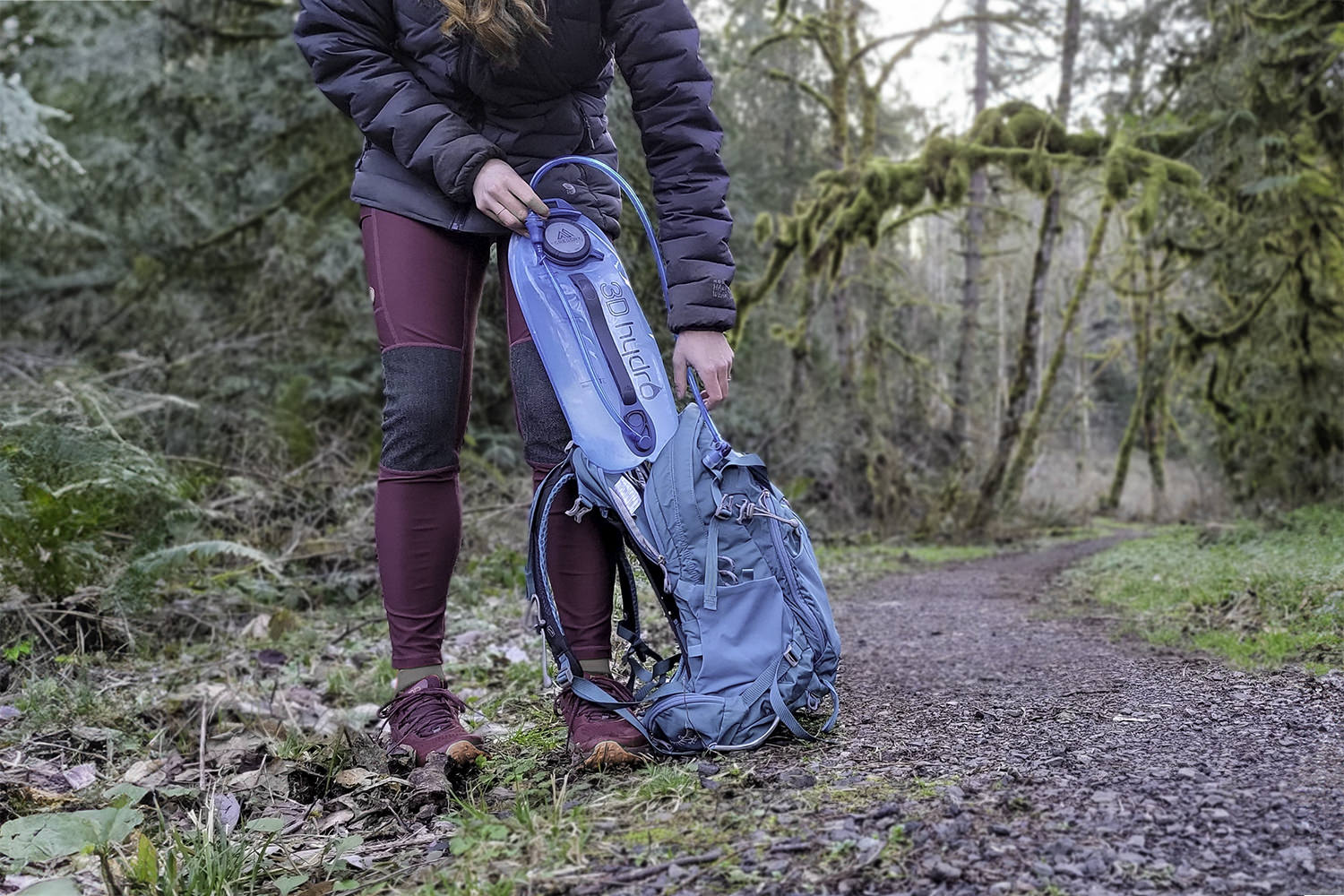
For convenient, hands-free hydration on the go, you’ll need a hydration bladder to put in your pack. We’ve used 46 bladders over the years from brands like CamelBak, HydraPak, Platypus, and more, ranging from the most basic options to reservoirs with all the bells and whistles. To help us identify the best, we consider features, weight, packability, taste, and more, across various price points.
We’ve searched the market and put each bladder to the test on hikes, runs, ski tours, and snowshoe trips. If you’re looking for a new hydration system, we’ll point you in the right direction. If you need additional accessories or integrated systems, we have you covered with our lists of the best hydration backpacks and water filters. If you’re also open to a classic container, we’ve tested and reviewed our favorite water bottles for trail and everyday use.
And for more info, check out some of our other most popular gear guides:
Quick Picks for Hydration bladders
Check out this quick list of our favorite hydration bladders or continue scrolling to see our full list with in-depth reviews.
Best hydration bladder overall: HydraPak Contour ($43)
Best ultralight hydration bladder: Platypus Platy ($20)
Hydration bladder with the best features: Gregory 3D Hydro ($50)
Best lightweight hydration bladder for filtration: CNOC Outdoors VectoX ($26)
Best value hydration bladder: CamelBak Crux ($37)
Best bladder for overnight backpacking: Osprey Hydraulics Reservoir ($48)
Best hydration bladder for cold weather: HydraPak HydraSleeve ($68)
Best water taste: Platypus Hoser ($34)
Most durable hydration bladder: HydraPak Seeker Water Bag ($25)
Best budget hydration bladder: Cherainti Hydration Bladder ($15)
What’s new
During our most recent round of testing, we added several new hydration bladders to our list while keeping our favorites. Some of our award winners have changed, as we’ve tested new products during our outdoor adventures.
- The HydraPak Contour has risen to the top of our list due to its excellent balance of weight, packability, and features.
- We added several lightweight water bags and flexible water bottles to the list, including the Platypus Platy, the HydraPak Seeker, and the CNOC VectoX.
- After reading very positive Amazon reviews, we decided to try the Cherainti Hydration Bladder and chose it as our top budget pick.
- For your cold weather adventures, we added the HydraPak Hydrasleeve, an insulated bladder designed to prevent water from freezing.
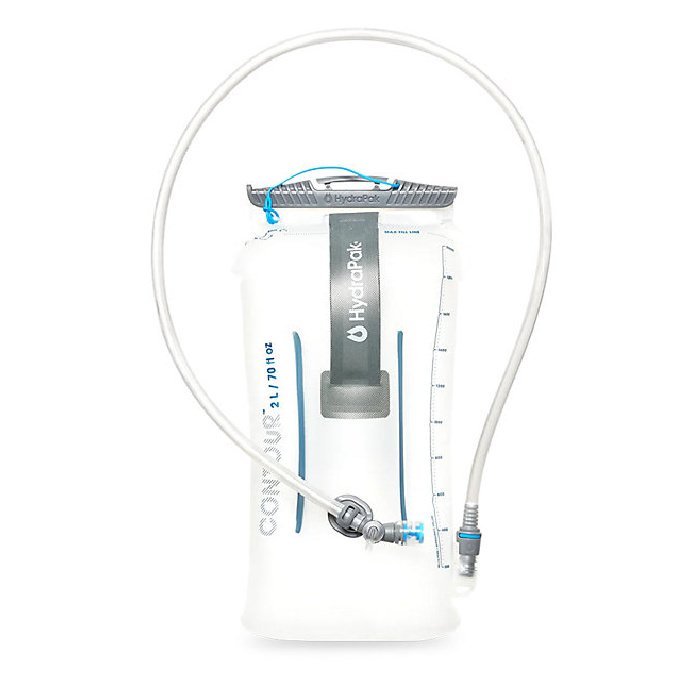
HydraPak Contour
Best overall hydration bladder
CleverHiker Rating:
4.8
Price:
$43
Weight:
5 oz.
Dimensions:
14.6″ x 7.5″
Capacities Available:
1.5L (lumbar), 2L, 3L
Pros
- Lightweight
- Can be turned inside out to dry
- Easy to clean
- Good balance of features to weight
Cons
- Slight plastic taste after cleaning
By balancing smart features with a lightweight and packable design, the HydraPak Contour wins the award for the best overall hydration bladder. At just 5 ounces, it’s one of the lightest bladders we tested that still has a hose and bite valve. While the Platypus Hoser weighs slightly less, the Contour offers useful features like a bite valve shutoff switch, a sternum strap magnet, interior baffles, and a lightweight handle. The plastic sliding closure adds some weight, but the wide opening significantly eases cleaning.
Our main critique of the Contour is that it retains a slight plastic taste, even after cleaning. However, several of the other bladders tasted much worse; the Contour’s plastic flavor was average in comparison. Folks on multi-day backpacking trips might also prefer a bladder with a bit more structure, like the Osprey Hydraulics Reservoir, so they can easily reload it into a full backpack.
We were impressed by how the Contour maintains its low weight without sacrificing too many features. Hikers, trail runners, and backpackers alike will appreciate this well-designed, versatile hydration bladder.
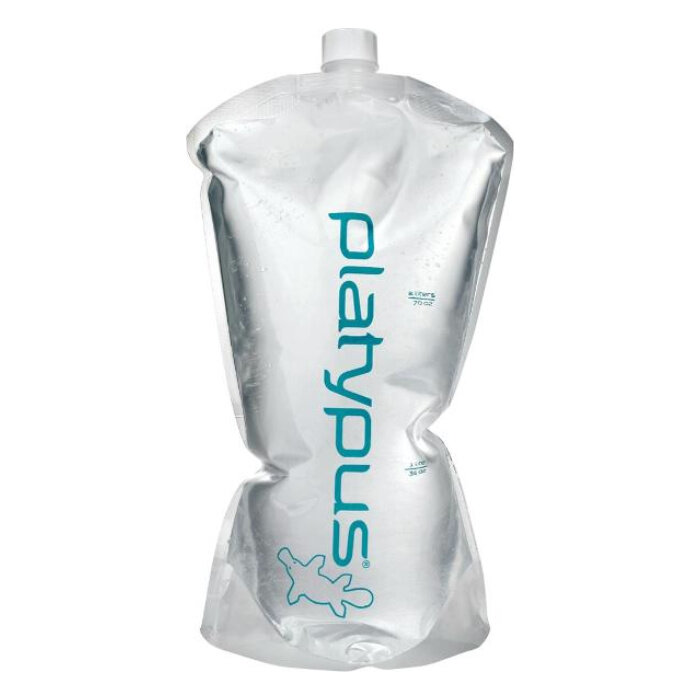
Platypus Platy
Best ultralight hydration bladder
CleverHiker Rating:
4.7
Price:
$19
Weight:
0.3 oz.
Dimensions:
13.8″ x 7.5″
Capacities Available:
2L
Pros
- Ultralight
- Packs up very small
- Virtually taste-free out of the package
- Affordable
Cons
- The seams tend to split eventually after hard use
- The lack of hose makes it impossible to drink while hiking
Alpine climbers and ultralight backpackers who count every ounce will appreciate this extremely lightweight, flexible bottle for long days in the mountains. When it’s empty, the Platy packs down to virtually nothing, making it a great choice for airplane travel as well. Platypus’s claim that the Platy is “taste-free” turned out to be true; of all the bladders we tested, the two products made by Platypus tasted the freshest right out of the package.
The Platy is not a complete hydration system with a hose and bite valve, so hikers who like to hydrate on the go should invest in a different bladder. It also has a limited lifespan; our main tester has used the Platy extensively, and it always eventually fails at the seams. She loves using it for multi-pitch rock climbing so much that she just keeps replacing it!
For those who prioritize weight above all else, the Platy is our most minimalist, ultralight choice. Although it has a limited lifespan, it can be replaced at an affordable price, so we continually return for more.
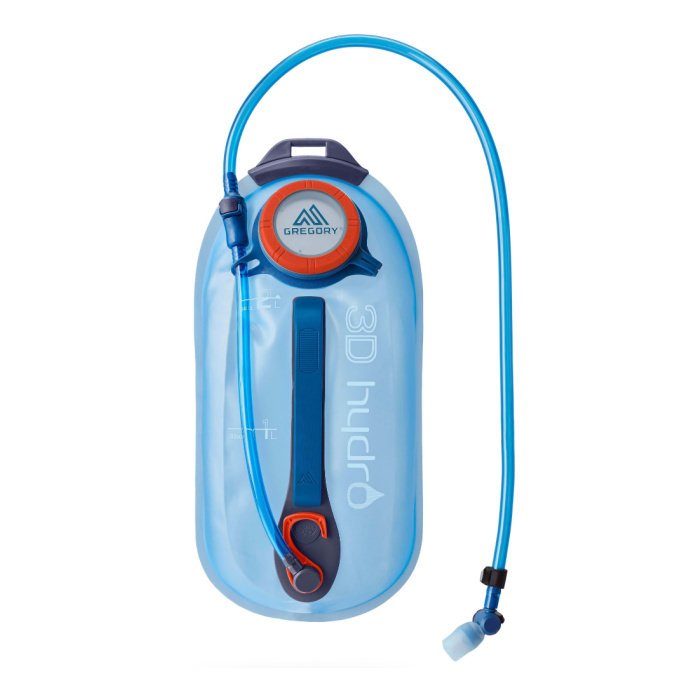
Gregory 3D Hydro
Hydration bladder with the best features
CleverHiker Rating:
4.6
Price:
$50
Weight:
6.5 oz.
Dimensions:
14.5″ x 7″
Capacities Available:
2L, 3L
Pros
- Easy to fill with hard plastic handle
- 3D structure makes it easier to load into backpack
- Sternum strap magnet prevents hose from flopping around
Cons
- Distinct iodine taste after it’s been cleaned
- Small twist-cap opening makes it harder to clean
Backpackers looking for a seamless experience will appreciate this well-designed hydration bladder. The 3D Hydro features include helpful elements that make it easy to fill, use, and clean, whether you’re heading out for a day hike or spending weeks in the mountains.
The rigid handle facilitates easy filling from a sink or stream, and it’s less awkward to load into a full backpack due to its 3D structure. We appreciate how the hose includes a quick disconnect located at the top of the bladder. This design prevents you from having to search in your backpack to reconnect the hose after a refill. Interior baffles stop water from sloshing, and a sternum strap magnet keeps the hose from flopping around while walking.
These premium features add some extra bulk, so alpine climbers and ultralight backpackers might want to consider a lighter-weight system. However, hikers seeking an easy-to-use hydration bladder will appreciate the Gregory 3D Hydro.
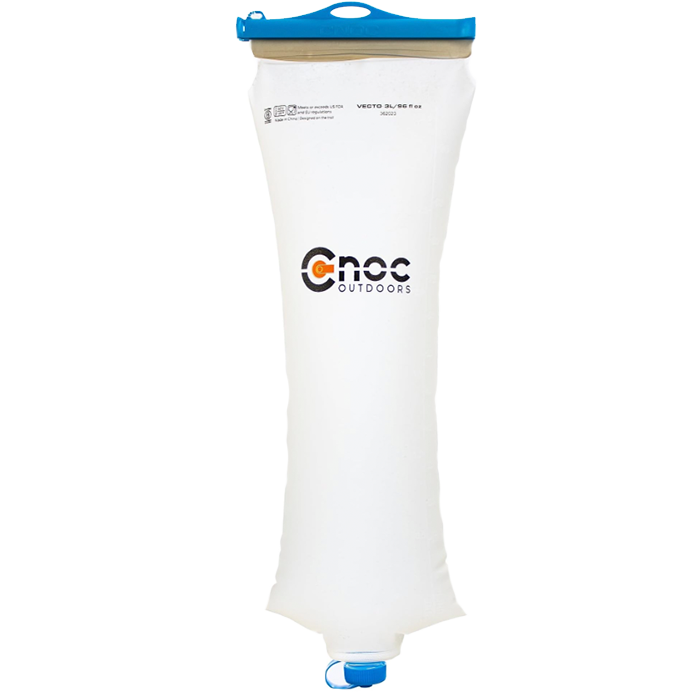
CNOC Outdoors VectoX
Best lightweight hydration bladder for filtration
CleverHiker Rating:
4.6
Price:
$26
Weight:
3.25 oz.
Dimensions:
13.5″ x 7″
Capacities Available:
2L, 3L
Pros
- Dries extremely quickly
- Wide opening makes it easy to fill
- Lightweight and packable
Cons
- No hydration hose
- Sand and dirt can get caught in slider
The VectoX addresses your backcountry water collection, filtration, and storage needs. With its wide opening, it’s easy to fill from any body of water, whether you’re camping near a lake or a stream. The 28mm size is designed for water filters with 28mm threads like the Sawyer Squeeze, but the VectoX also features a 42mm thread size to accommodate larger filters like the Katadyn BeFree. If you pack two VectoX bladders, you can easily set up a gravity filtration system right at camp.
While it’s possible to drink from it directly, the VectoX isn’t the most convenient hydration system. It lacks a hose and bite valve, and its floppy material makes it more challenging to use like a water bottle compared to the slightly stiffer Platy. The VectoX is better suited as a system for collecting and filtering large amounts of water while camping with a group. This can be especially beneficial if you end up pitching your tent far from a water source.
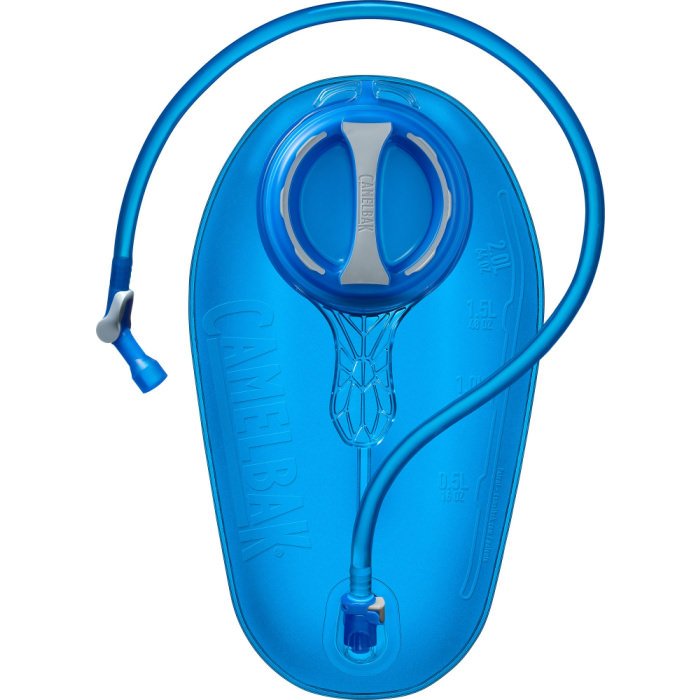
CamelBak Crux
Best value hydration bladder
CleverHiker Rating:
4.5
Price:
$37
Weight:
7 oz.
Dimensions:
15″ x 7.5″
Capacities Available:
1.5L, 2L, 3L
Pros
- Water doesn’t taste like plastic
- Water flows easily
- Plastic handle makes it easy to fill
- Affordable price for the features it includes
Cons
- Bulkier and heavier than other options
The CamelBak Crux offers an excellent hydration experience at an affordable price, earning it our award for best value. The large plastic handle makes filling it easy, and it features essential components like a bite valve shutoff switch. Water flows smoothly through the bite valve, and it tastes quite fresh as well. Although it’s not the fastest bladder to dry, the large twist cap opening allows for thorough cleaning inside.
The Crux doesn’t have as many bells and whistles as the Gregory 3D Hydro or the Osprey Hydraulics Reservoir, nor is it as lightweight and packable as the HydraPak Contour. However, at its price point, we still believe it’s a great option for many hikers and backpackers.
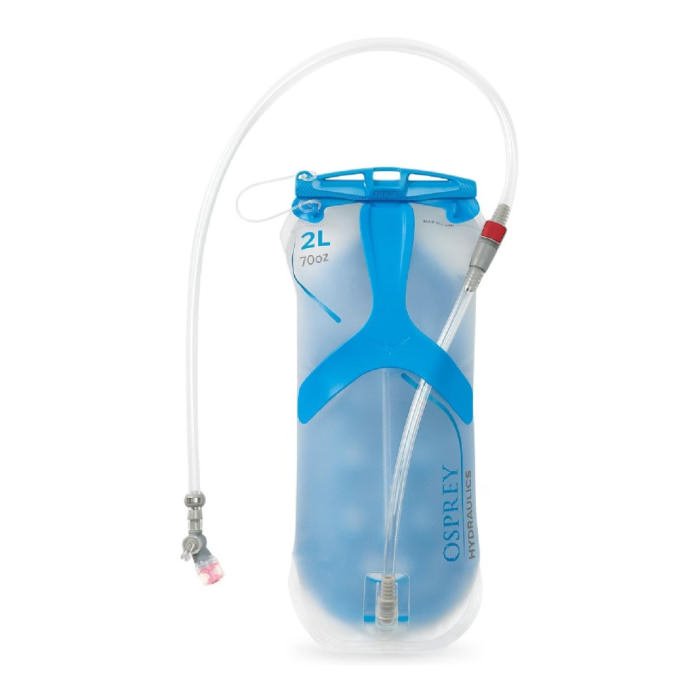
Osprey Hydraulics Reservoir
Best bladder for overnight backpacking
CleverHiker Rating:
4.4
Price:
$48
Weight:
6.4 oz.
Dimensions:
15.4″ x 6.9″
Capacities Available:
2L, 3L
Pros
- Tons of smart features
- Rigid back plate helps while loading it into full backpacks
- Large slider opening makes it easy to clean
- Affordable price for the features it includes
Cons
- More expensive than others
- Bulky and heavier than others
- Retains distinct iodine flavor in the water
The Osprey Hydraulics Reservoir is the only bladder we tested that features a rigid back plate. For backpackers carrying overnight packs, this added structure significantly aids in reloading the bladder after refilling it. The hose quick disconnect is also positioned near the top of the bladder, so you won’t need to sift through your gear to reconnect the hose after a refill. The Hydraulics comes with several additional features, including a sternum strap magnet, a plastic handle for easy filling, and a bite valve shutoff switch.
This premium design comes at a cost; the Hydraulics Reservoir is one of the most expensive hydration bladders on the list, and the extra features add bulk and weight. The Hydraulics also had one of the most distinct iodine tastes of any that we tested, including our budget option.
If you’re hoping to shed ounces and bulk, you may consider a different option from our list.
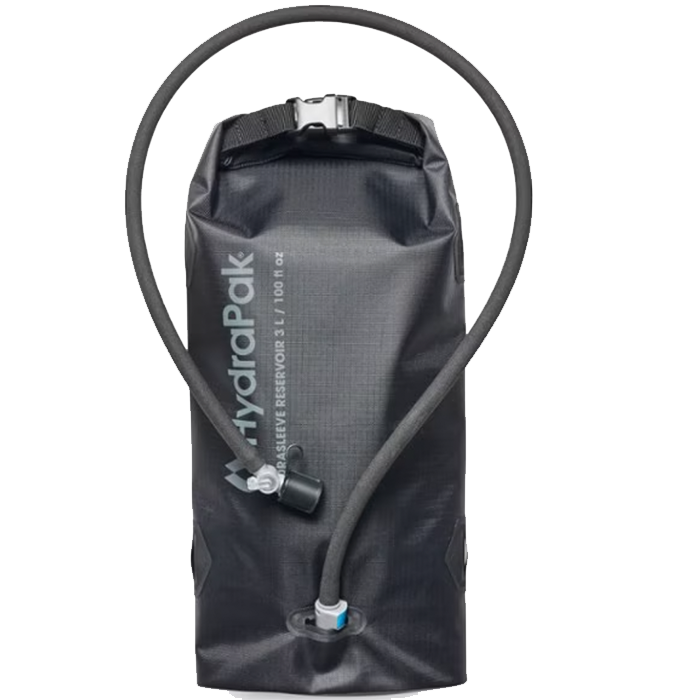
HydraPak HydraSleeve
Best hydration bladder for cold weather
CleverHiker Rating:
4.4
Price:
$68
Weight:
10.8 oz.
Dimensions:
18″ x 9″
Capacities Available:
3L
Pros
- Insulated sleeve prevents water from freezing or heating up
- Comes with insulated hose
- Durable sleeve protects bladder from wear and tear
Cons
- Most expensive bladder on the list
- Heavier and bulkier than all of the others
We’re confident that the HydraSleeve is the only bladder on our list that features a hose that won’t freeze in frigid temperatures. If you’re snowshoeing, cross-country skiing, or ski touring, this insulated bladder will ensure that water keeps flowing as you move through the snow.
Compared to the HydraPak Contour, whose hose completely froze within an hour of snowshoeing in 15-degree temperatures, the HydraSleeve’s insulated hose remained functional down to single digits during a ski tour in Jackson, Wyoming. If you’re on a hot weather hike, the HydraSleeve will also keep your water refreshingly cool, especially if you toss in some ice cubes before heading out the door!
The HydraSleeve provides insulation through extra weight, bulk, and cost, making it a worthwhile investment only if you plan to recreate in significantly cold or hot weather. Based on our tests with the Contour, it seems that the hose is the most prone to freezing. If you want to stay hydrated in the cold but prefer to avoid the extra bulk, consider one of our bladders without a hose. Both the Platypus Play and the HydraPak Seeker are also unlikely to freeze, especially when stored inside your backpack.

Platypus Hoser
Best water taste
CleverHiker Rating:
4.3
Price:
$37
Weight:
3.8 oz.
Dimensions:
16.5″ x 7″
Capacities Available:
1L, 1.8L, 2L, 3L
Pros
- Ultralight and packable
- Taste free
- Good flow rate
- Affordable price
Cons
- Minimal features
- Lack of bite valve shutoff switch caused some leaking
- Difficult to clean without special kit
With the Hoser, Platypus has succeeded in making a “taste-free” bladder, which seems surprisingly difficult to accomplish. Almost all other reservoirs retained some plastic taste, even after being washed. Only one other Platypus product – the Platy – was similarly tasteless.
Like the Platy, the Hoser is lightweight and minimalist, but it also features a hose and bite valve, whereas the Platy does not. While the Hoser’s simple design has its advantages, it also comes with some drawbacks; lacking a shutoff switch on the bite valve, we experienced some leaking issues in our pack. Out of all the bladders we tested, it is also the most difficult to clean, due to its very small, twist-cap opening.
For ultralight backpackers who want to hydrate on the go and are ready to sacrifice some features to save weight, the Hoser is a great choice.
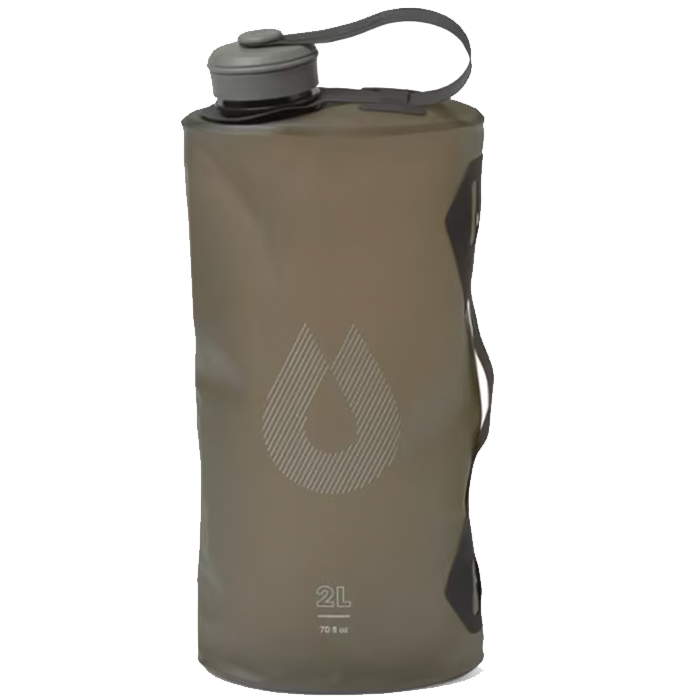
HydraPak Seeker Water Bag
Most durable hydration bladder
CleverHiker Rating:
4.2
Price:
$25
Weight:
2.7 oz.
Dimensions:
12.5″ x 5.1″
Capacities Available:
2L, 3L, 4L, 6L, 10L
Pros
- Durable
- Lightweight and packable
- Affordable price
Cons
- Retains rubbery taste
- Hard to drink out of wide mouth opening
- Dark color causes water to heat up quickly in the sun
If you want a lightweight bladder that is more durable than the Platy, the HydraPak Seeker gets the job done. Without a hose and bite valve, it falls within the category of ultralight water bags. Unlike the Platy, it doesn’t tend to fail at the seams easily, earning it our durability award. We’ve tested the Seeker through multiple seasons of hiking and climbing, and so far, we haven’t encountered any issues with leaks or tears.
We find the Seeker a bit more challenging to drink from than the Platy or VectoX. The large opening, combined with the flexible material, has led us to spill water on ourselves more times than we’d care to admit. Additionally, it doesn’t taste as fresh as either of the other ultralight, minimalist options.
Despite these drawbacks, the HydraPak Seeker water bag is an option that will stand the test of time. Climbers and ultralight backpackers who don’t want to keep replacing their ultralight hydration system will appreciate the HydraPak Seeker.
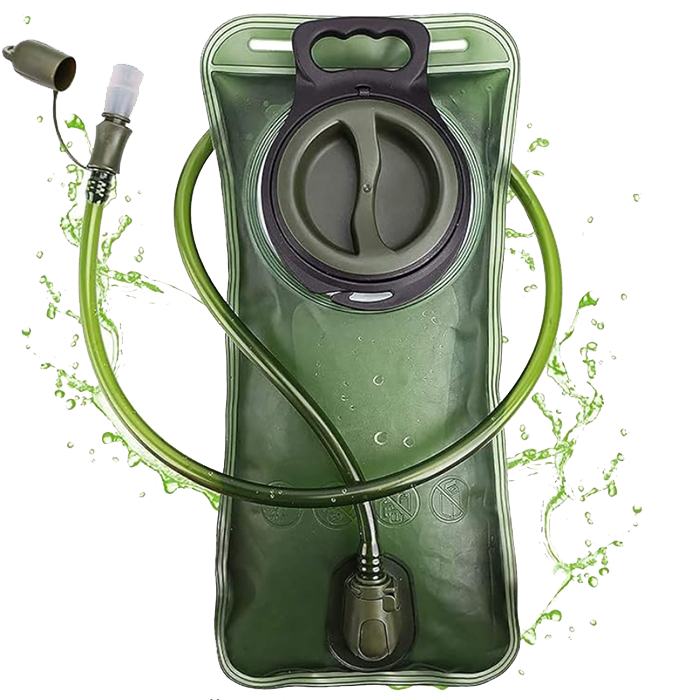
Cherainti Hydration Bladder
Best budget hydration bladder
CleverHiker Rating:
4.0
Price:
$13
Weight:
5.13 oz.
Dimensions:
14.2″ x 6.8″
Capacities Available:
1.5L, 2L, 3L
Pros
- Affordable
- Includes bite-valve cover
Cons
- Significant plastic taste after washing
- Dark color causes water to warm up more quickly
- On-off valve is hard to use
We were curious to test the Cherainti Hydration Bladder after noticing it had over 20,000 reviews on Amazon and a 4.5-star average. It’s also significantly cheaper than any other bladder we tested, including those without hydration hoses.
Even at its low price, the Cherainti Bladder performed quite well; we didn’t notice many significant drawbacks during our field testing. Its features are limited, yet it includes a functional hose and a bite valve with a cover. The bite valve shutoff mechanism doesn’t seem as secure as the lever found on other models. We have concerns about potential leaking, but so far it hasn’t soaked our gear. Our biggest complaint is likely the plastic taste, but some of the more expensive options actually taste worse.
If you’re just starting out with backpacking and feeling overwhelmed by pricey gear, the Cherainti Bladder is a great budget option. Plus, it even comes with a free camo-patterned buff!
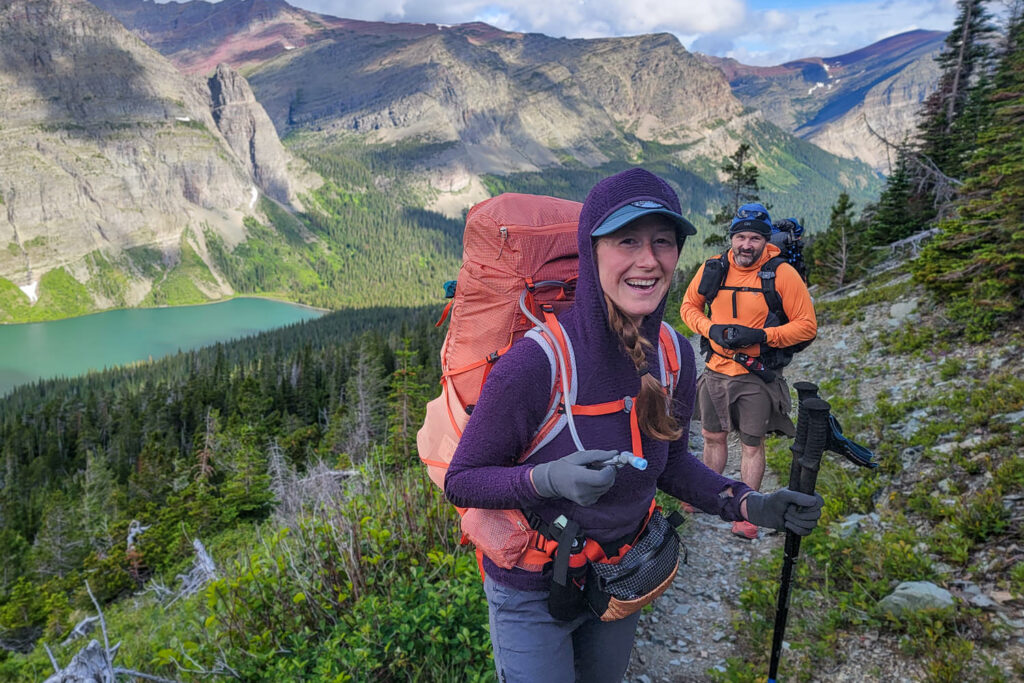
Product Comparison Table
| oSort | Product | Price | Weight | Dimensions | Capacities Available | Packability | Taste | Ease of Use | Ease of Cleaning | Durability | 0 |
HydraPak Contour View at Amazon View at HydraPak |
$43 | 5 oz. | 14.6″ x 7.5″ | 1.5L (lumbar), 2L, 3L | 4.6 | 4.2 | 4.7 | 4.6 | 4.4 | 1 |
Platypus Platy View at REI View at Amazon |
$19 | 0.3 oz. | 13.8″ x 7.5″ | 2L | 4.8 | 4.8 | 4.2 | 3.9 | 3.9 | 2 |
Gregory 3D Hydro View at REI View at Backcountry |
$50 | 6.5 oz. | 14.5″ x 7″ | 2L, 3L | 4.0 | 3.8 | 4.7 | 4.0 | 4.4 | 3 |
CNOC Outdoors VectoX View at Amazon View at Garage Grown Gear |
$26 | 3.25 oz. | 13.5″ x 7″ | 2L, 3L | 4.6 | 4.5 | 4.0 | 4.8 | 4.3 | 4 |
CamelBak Crux View at REI View at Amazon |
$37 | 7 oz. | 15″ x 7.5″ | 1.5L, 2L, 3L | 4.0 | 4.6 | 4.4 | 4.3 | 4.3 | 5 |
Osprey Hydraulics Reservoir View at REI |
$48 | 6.4 oz. | 15.4″ x 6.9″ | 2L, 3L | 3.8 | 3.8 | 4.8 | 4.0 | 4.4 | 6 |
HydraPak HydraSleeve View at REI |
$68 | 10.8 oz. | 18″ x 9″ | 3L | 3.8 | 4.2 | 4.5 | 4.6 | 4.8 | 7 |
Platypus Hoser View at Amazon |
$37 | 3.8 oz. | 16.5″ x 7″ | 1L, 1.8L, 2L, 3L | 4.6 | 4.8 | 4.0 | 3.8 | 4.0 | 8 |
HydraPak Seeker Water Bag View at REI |
$25 | 2.7 oz. | 12.5″ x 5.1″ | 2L, 3L, 4L, 6L, 10L | 4.6 | 4.0 | 4.0 | 3.8 | 4.5 | 9 |
Cherainti Hydration Bladder View at Amazon |
$13 | 5.13 oz. | 14.2″ x 6.8″ | 1.5L, 2L, 3L | 4.0 | 3.8 | 4.0 | 4.3 | 4.2 |
|---|
var resetClicked = false;
// When the Reset Table button is clicked, use sortable to reset to the oSort column.
document.querySelector(‘#resetSort’).addEventListener(‘click’, function() {
// If reset has been clicked, do nothing
if (resetClicked) {
return;
}
// Get the defaultSort element and click it to reset sort to the original load order.
const el = document.getElementById(‘defaultSort’)
if (el) {
el.click();
resetClicked = true;
}
});
// Add event listener to all sortable headers to reset the resetClicked flag
var headers = document.querySelectorAll(‘.sortable th’);
headers.forEach(function(header) {
header.addEventListener(‘click’, function() {
resetClicked = false;
});
});
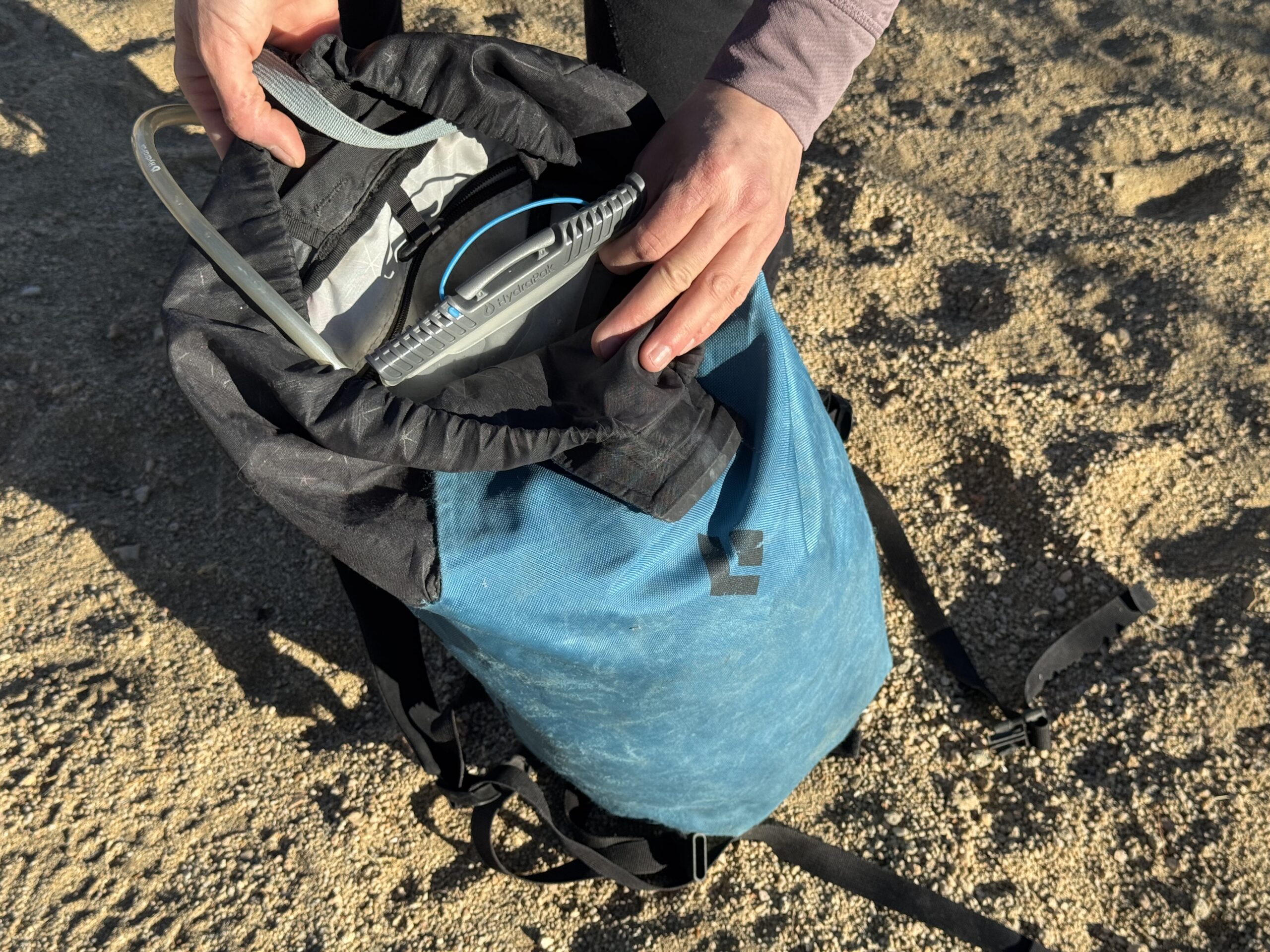
How We Test
We analyzed weight and packability, ease of use, ease of cleaning, taste, and durability. Through comparative tests and extensive field use, we scored each bladder based on its performance in these categories.
WEIGHT & PACKABILITY
As backpackers, we typically carry all of our overnight essentials on our backs, so lightweight gear can make the experience much more enjoyable.
We measured each bladder on a scale to cross-reference the weight listed on the manufacturer’s site. When evaluating this category, we awarded high marks for the absolute lightest weight but also gave points to products that managed to incorporate features while maintaining a low weight.
To assess packability, we measured the minimum packed size of each product. First, we rolled each bladder into the smallest package possible and secured it with rubber bands. Next, we measured its length, width, and height to evaluate its packability.
TASTE
Some of the bladders we tested were virtually taste-free right out of the package, while others retained a strong iodine or rubbery taste even after being thoroughly washed. After scrubbing and drying each bladder, we conducted a side-by-side taste test to compare the flavors. We also checked the materials and ensured we only included products that were guaranteed to be BPA-free.
EASE OF USE
To measure ease of use, we examined how the features of each bladder affected our user experience in the field. We also conducted a few comparative tests to evaluate the flow rate from the bite valve and the ease of filling.
Smart features can enhance the user experience, but it’s important to know which ones you value most. The products we tested range from minimalist water bags to hydration bladders equipped with various additional features. Some features to consider include a hose and bite valve, a shutoff switch for the bite valve, a sternum strap magnet, a sliding closure or twist cap, a quick disconnect for the hose, and a handle for easy filling.
Some bladders include structural elements such as internal baffles or rigid back plates. Internal baffles can help prevent water from sloshing around during high-impact activities like trail running. A rigid back plate helps maintain the bladder’s shape and makes it easier to load into a fully packed backpack. More features don’t always equate to better; they come with the costs of weight, bulk, and sometimes expense.
To assess the flow rate from the bite valve, we conducted a gravity test. Holding each bladder in the air, we pinched the valve and measured the amount of water that flowed into a cup in ten seconds. The results generally indicate how easily water flows through the hose when sucking on the bite valve. We also wanted to assess how easy it would be to fill each bladder in the field without a sink. Since our testing primarily took place during the winter in the desert, we simulated a shallow body of water using a bathtub. By filling the tub up to six inches, we evaluated how close to maximum capacity we could fill each bladder without using a hard-sided water bottle.
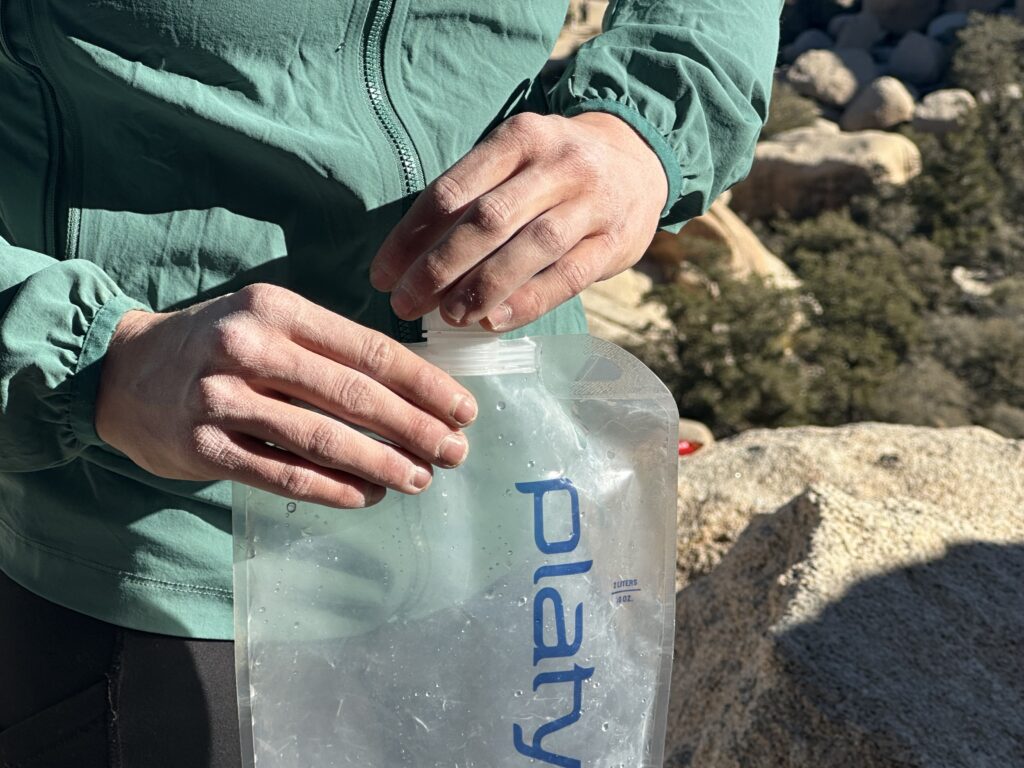
EASE OF CLEANING
The design of each hydration bladder significantly affects how easy it is to clean and dry. Generally, bladders that close with a plastic slider are easier to scrub thoroughly than those with a twist cap. The wide opening allows you to fit a hand or sponge inside.
To evaluate this category, we tested which bladders were easy to clean with a kitchen sponge, which were dishwasher safe, and which required special cleaning kits for thorough washing. After scrubbing them as best we could, we hung the bladders outside in the sun and timed how quickly they dried.
DURABILITY
While true durability requires multiple seasons of testing, we could evaluate any leaks or durability issues during our test period. Each bladder was taken on a minimum of three hikes, runs, snowshoe trips, or ski tours, with notes on any spills or leaks in our packs. We also used each bladder for a day of rock climbing, stuffing them into a backpack filled with metal climbing gear. Testing products in the desert exposes us to spiky plants, rough rock, and varying conditions.
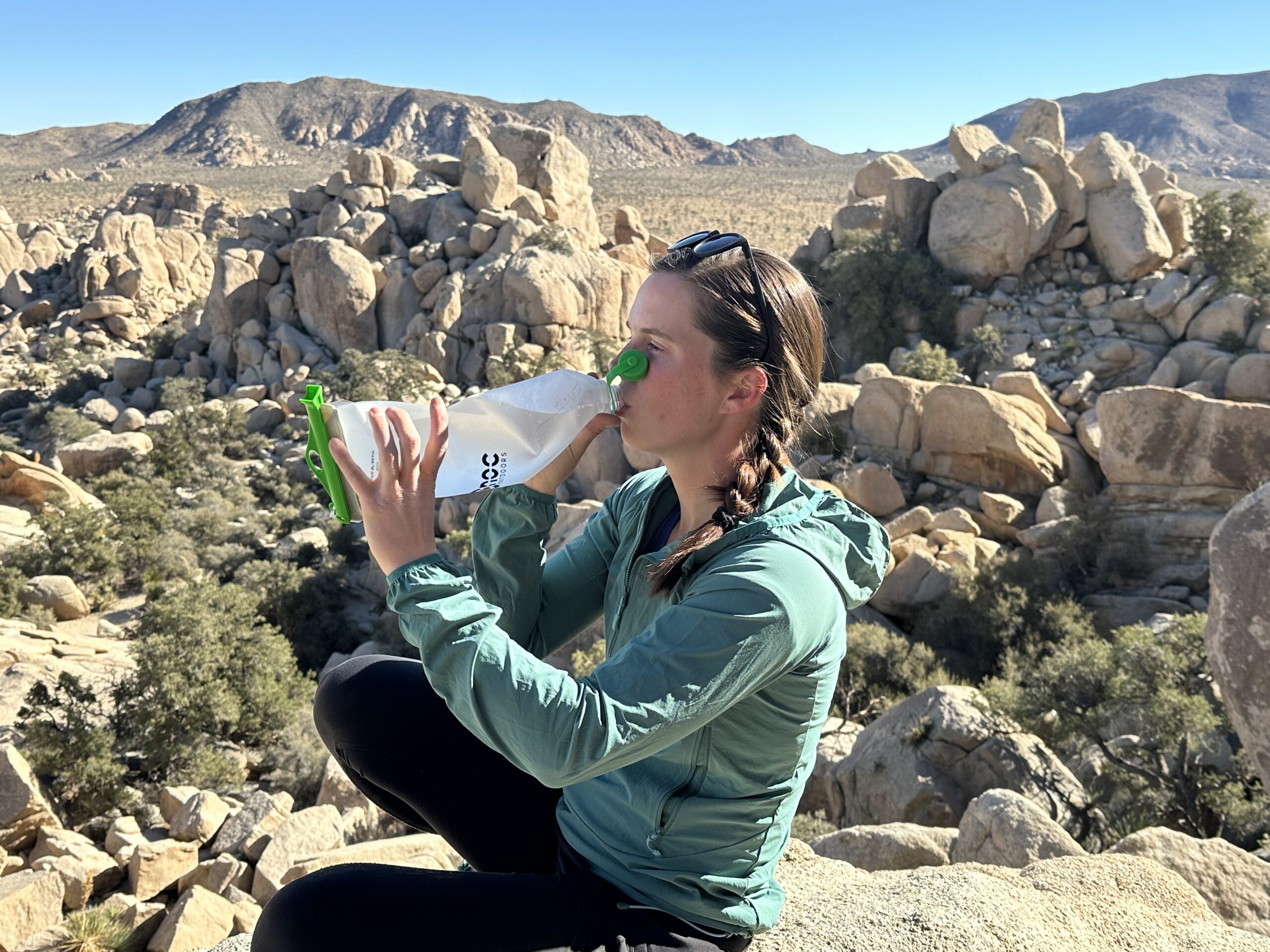
Why Trust Cleverhiker
Gear Analyst Katie Griffith has been a professional outdoor educator and guide for fourteen years. She has led dozens of multi-week backpacking and canoeing trips in Minnesota and the Rocky Mountains. Additionally, she has guided glaciated peaks in the Cascades and currently works year-round as a rock and alpine climbing guide. She is an AMGA Assistant Rock Guide, Apprentice Alpine Guide, and Certified Single Pitch Instructor, as well as a Wilderness First Responder and a Leave No Trace Trainer.
The more time she spends recreating and working outdoors, the more Katie appreciates well-made products. Spending over 175 days in the field each year, Katie puts all of her gear through the ringer. She knows firsthand that reliable products not only make outdoor experiences more enjoyable, but they can also help manage risk when things go south. Gear that stands the test of time contributes to the sustainability of the outdoor recreation industry as well. She cares about protecting the natural places she loves, so sustainably sourced materials and durable products are her top priorities.
Analysis & Results
VALUE
When we consider value, we’re looking for the hydration bladder that provides the best experience at the lowest price. The Camelbak Crux features a variety of useful elements, is easy to clean, and does not have a plastic taste. It achieves all of this at a relatively low cost, making it our choice for best value. The Cherainti Bladder is a solid budget option for those looking for the cheapest price, but we believe the Crux justifies the additional investment.
The Hoser is another noteworthy option in the budget category, particularly for recreationalists looking to reduce both weight and costs. It’s priced similarly to the Crux but nearly halves the weight. The Hoser achieves this lightweight design by simplifying its features, resulting in trade-offs for the user experience.
TASTE
Among the worst-tasting hydration bladders were also the most expensive. The Gregory 3D Hydro and the Osprey Hydraulics Reservoir both retained a distinct iodine flavor, even after thorough cleaning.
The Cherainti Bladder had a rubbery taste, and all of the HydraPak reservoirs held onto a slight plastic flavor. After cleaning, the Camelbak Crux and VectoX had very little flavor, while the Platy and the Hoser actually lived up to Platypus’s “taste-free” claim, even right out of the package.
WEIGHT & PACKABILITY
There are clear winners for the absolute lightest weight and smallest packed size; minimalist products like the Platy or HydraPak Seeker are the top choices for anyone looking to cut down on weight as much as possible. Both of these hydration bags feature minimalist designs, comprising little more than a twist cap and a reservoir.
It’s also worth acknowledging designs that efficiently incorporate features while keeping weight down. The HydraPakContour manages to stay under six ounces while offering a wide array of features, which is why it won the prize for best overall. The stripped-down Platypus Hoser includes a reservoir, hose, and bite valve, while achieving a weight that’s just under four ounces. Neither the Hoser nor the Contour contains many bulky plastic parts, so both are also quite packable.
EASE OF USE
The two most feature-rich bladders on our list are the Osprey Hydraulics Reservoir and the Gregory 3D Hydro. Both come with a rigid handle for filling the bladder, a sternum strap magnet to prevent the hose from flopping around, and a bite valve shutoff switch. The Gregory 3D Hydro also features a hook for hanging the bladder while it dries. The Osprey Hydraulics Reservoir is the only bladder with a rigid back plate, making it easier to load into a fully packed overnight backpack.
During our field testing, the most crucial feature turned out to be a bite valve shutoff switch. The Platypus Hoser was the only bladder without one, leading to leaks all over a down jacket in our backpack. While the other features were nice, they didn’t significantly influence our experience. We observed that the sternum strap magnets attracted a lot of sand during our testing in the desert, which reduced their effectiveness.
During our flow test, we found that the Platypus Hoser and the CamelBak Crux had the highest flow rates, filling 1.5 cups and 1.25 cups in ten seconds, respectively. These two bladders also provided the best overall drinking experience, as they both tasted better than the other bladders. Conversely, the Cherainti Bladder had the lowest flow rate at 0.4 cups in ten seconds.
The results of our fill test show that the bladders with the smallest openings were the most difficult to fill. The Platypus Hoser was the trickiest overall; we barely managed to fill it to half a liter. We could only get about a liter into the Platy and the Seeker. We recommend bringing a hard-sided water bottle to assist with filling these on an overnight trip. We successfully filled most of the other bladders to capacity by dunking them underwater.
EASE OF CLEANING
The hydration bladders with sliding closures are generally the easiest to clean and dry. Thanks to the wide opening, most of these bladders can be turned inside out, making it simple to thoroughly scrub the interior. This also aids in quick drying, reducing the chance of mold buildup. The VectoX stands out in this category; after being turned inside out and hung up, it was completely dry within twenty minutes. The HydraPak HydraSleeve and Contour were also quite fast to dry, taking 30 minutes and an hour, respectively.
The Osprey Hydraulics is an exception; even though it has a sliding closure, its rigid back plate makes it impossible to turn inside out. Our main tester was able to fit her hand inside the bladder to clean it out, but she has smaller-than-average hands. The bladders with twist caps were a mixed bag. Some, like the CamelBak Crux and the Cherainti Bladders, have larger openings and are easy to clean.
The Gregory 3D Hydro has a small opening, making it harder to scrub the inside without special tools. These also dried slowly, with most taking over seven hours to be completely moisture-free.
The hardest bladders to clean and dry were those with the smallest twist-cap openings, like the Platypus Platy and the Hoser. Fortunately, Platypus offers a special cleaning kit with a long brush to scrub hard-to-reach areas. The Platy is also one of the few bladders we tested that is dishwasher safe.
DURABILITY
During our testing period, none of the bladders had any structural failures that we observed. We took each product on multiple hikes, runs, snowshoe excursions, and ski tours. We also packed many of the bladders into a fully stuffed backpack filled with climbing gear. The only leak we noticed was from the Platypus Hoser, which is the only hydration bladder that lacks a shutoff switch on the bite valve. When we packed it into a climbing pack, it leaked all over a down jacket.
From past experience with the Platy, our main tester knows that this product has a limited lifespan. She has owned several Platys before, and they eventually tend to fail at the seams and start leaking. She has also used the HydraPak Seeker extensively and has yet to replace it.
How to Choose a Hydration Bladder
There are advantages and disadvantages to each hydration bladder, and many of them serve specific purposes.
HOW MUCH WATER SHOULD I CARRY?
The liquid capacity of a hydration bladder is typically measured in liters (L), with most holding between 1L and 3L. Water is heavy (1L weighs about 2 lbs.), so it’s important to carefully consider how much you’ll actually drink and plan accordingly.
Having a larger maximum capacity can be beneficial for long days on the trail, but you don’t need to fill your reservoir to the brim if you want to keep your load light. To estimate how much water you’ll need to carry, a good rule of thumb is to aim for 0.5L per hour for moderate activity in mild temperatures. You may need to adjust this depending on conditions and personal preferences. Strenuous hiking in high heat may require 1L of water or more per hour.
When determining your maximum capacity, it’s also important to consider the environment where you’ll be recreating. For a desert backpacking trip, you may need to carry multiple days’ worth of water at a time, so a large capacity (4+ liters) water storage bag will be essential. If you’re hiking on trails that lack a water source all day, you’ll want at least 2-3L of capacity for a full day of hiking.
DO I WANT TO HYDRATE ON THE GO?
While most of the hydration bladders we tested include a hydration hose and bite valve, some of our minimalist options do not. Many backpackers and hikers prioritize the ability to hydrate on the go. With a convenient hose system, you won’t have to stop and pull out a water bottle every time you want to quench your thirst.
For some ultralight backpackers or alpine climbers, forgoing a hose is worthwhile for the weight savings. Those who recreate in winter or cold weather environments may also opt against a hose system because they tend to freeze in frigid temperatures. Our tester is an avid multi-pitch rock climber, and she prefers a hose-less bladder to minimize additional gear dangling while climbing.
HOW DO I LIKE TO RECREATE?
The hydration system you choose may also depend on your preferred outdoor recreation activity. Overnight backpackers may value additional features that make their bladders easier to fill and carry in a fully packed backpack. With its rigid backplate and easily accessible quick disconnect, the Osprey Hydraulics Reservoir fulfills that niche well.
Trail runners may be more willing to sacrifice features for a lightweight bladder. The Hydrapak Contour sheds ounces while still offering some helpful features, making it a great choice for trail runners or ultralight backpackers. The interior baffles help prevent water from sloshing around during high-impact activities, and the magnetic sternum strap keeps the hose in place.
Alpine climbers may prefer a simpler system while high on a cliff face; dangling hoses can actually be a nuisance. Therefore, climbers might choose an ultralight, flexible water bottle like the Platypus Platy or HydraPak Seeker. Additionally, hoses tend to freeze in cold temperatures at high elevations, making these water bags a better alternative for mountaineering, snowshoeing, ski touring, or other cold weather activities.
FILTERING WATER USING A HYDRATION BLADDER
If you plan to refill your hydration bladder from natural sources on the trail, you’ll need to carry a filtration method to ensure the water is safe to drink. Chlorine Dioxide Drops / Pills are lightweight and affordable, although they require a waiting period.
You can choose from reservoir filter kits, or you can create your own inline system by ordering an extra quick connect kit, bite valve, and a Sawyer Squeeze. Another option is to use a filter like the Katadyn BeFree to scoop and filter water into your hydration bladder.
As mentioned above, certain bladders are more compatible with specific filters. Check out our Best Water Filters list for a comprehensive overview of our favorite water filtering methods for hiking.
HYDRATION BLADDER CARE
Most hydration bladders have polyethylene linings, which retain tastes and odors more readily than polycarbonate bottles. For this reason, we recommend only filling them with water. The best method to maintain any plastic water bottle or bladder is to rinse it after each use and allow it to air dry completely.
Periodically add a fizzy cleaning tablet, such as those from Bottle Bright, or mix in a tablespoon each of bleach and baking soda, then let it sit overnight. This, combined with a thorough scrubbing using a bottle brush, will keep grime, unpleasant flavors, and odors at bay.

Conclusion
With a variety of features, weights, and prices, choosing the right hydration bladder for your outdoor adventures can be tricky. That’s why we’ve scoured the market and thoroughly tested each bladder on the list. After extensive field use and comparative analysis, we’re confident we’ve presented the best hydration bladders for this season.
The post Best Hydration Bladders of 2025 appeared first on CleverHiker.


